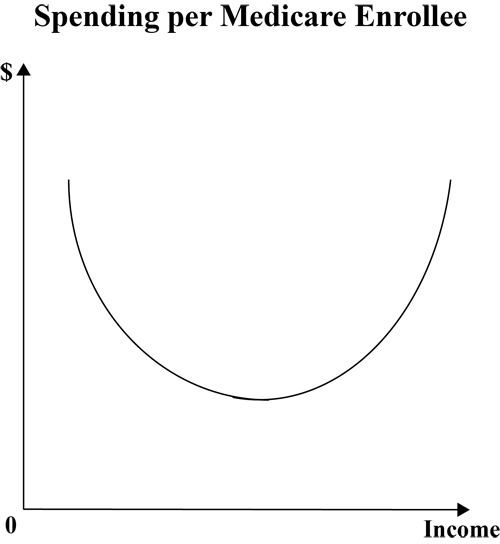Inequality Results Explained
Austin Frakt draws our attention to a BMJ article that finds a positive relationship between hospital readmissions and inequality. A number of explanations are offered, but to put it charitably, none are persuasive. Here is a different explanation: If you graph health care spending against income you will generally get a U-shaped curve. (See below.) The reason: poor people are sicker and need more health care and since health care is a luxury good, wealthier people spend more on it. An NCPA study found that for Medicare patients, the highest level of spending was among the highest and lowest income enrollees.
So where you have inequality (poor and rich bunched together) you will get high spending and where you have equality (everybody’s average) you will have low spending.



Health status is correlated with wealth. Poor people tend to be in worse health than rich people. Low income individuals’ poor health status may be due to poor health literacy (i.e. they don’t know about healthy lifestyles). Or it may be that poor people discount the future costs and benefits of the decisions they make. Or it may be genetics where poor health resulted in low income.
The somewhat weak correlation about the U-shaped health spending (illustrated in the graphic above) has been known for some time. Poor (uninsured) people often put off seeing the doctor until the reach Medicare eligibility. Rich people feel entitled and demand a higher level of assurance. The middle-income people tend to fall in the middle. They’re healthier than the poor, and probably as healthy as the rich. But they don’t have the sense of entitlement and often have a stern resilience about them. Think of Minnesota and Wisconsin. Both have relatively low medical spending. Compare that to high spending areas like Boca Raton, Florida and Brownsville, Texas.
The correlation of poor people being more unhealthy than richer people is a very pervasive notion. Poor people may not be able to afford the right quality and quantity of food in their diets, may not be as literate on healthy habits, may put off going to a doctor completely…all due to financial constraints.
Interesting, but not surprising.
Interesting result. I’ve never seen this before.
For the poor, perhaps this can be explained with the “buffet” analogy: poor college students eat as much as possible at a buffet, because they pay nothing for each additional food item. The poor consumer of healthcare functions the same way – each additional trip to the doctor costs them nothing (or close to it), so they overuse the good.
Since the supply of healthcare cannot keep up with the demand for healthcare at the poor’s $0 price, the entire market suffers from “the Tragedy of the Commons”.
Neat graph.